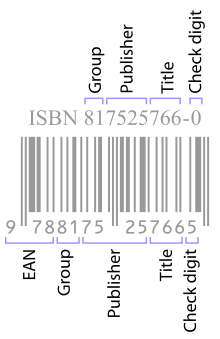International Standard Book Number
The International Standard Book Number (ISBN) is a numeric commercial book identifier that is intended to be unique.[a][b] Publishers purchase ISBNs from an affiliate of the International ISBN Agency.[1]
An ISBN is assigned to each separate edition and variation (except reprintings) of a publication. For example, an e-book, a paperback and a hardcover edition of the same book will each have a different ISBN. The ISBN is ten digits long if assigned before 2007, and thirteen digits long if assigned on or after 1 January 2007.[c] The method of assigning an ISBN is nation-specific and varies between countries, often depending on how large the publishing industry is within a country.
The initial ISBN identification format was devised in 1967, based upon the 9-digit Standard Book Numbering (SBN) created in 1966. The 10-digit ISBN format was developed by the International Organization for Standardization (ISO) and was published in 1970 as international standard ISO 2108 (the 9-digit SBN code can be converted to a 10-digit ISBN by prefixing it with a zero digit '0').
Privately published books sometimes appear without an ISBN. The International ISBN Agency sometimes assigns such books ISBNs on its own initiative.[3]
Another identifier, the International Standard Serial Number (ISSN), identifies periodical publications such as magazines and newspapers. The International Standard Music Number (ISMN) covers musical scores.
The Standard Book Number (SBN) is a commercial system using nine-digit code numbers to identify books. It was created by Gordon Foster, Emeritus Professor of Statistics at Trinity College, Dublin,[4] for the booksellers and stationers WHSmith and others in 1965.[5] The ISBN identification format was conceived in 1967 in the United Kingdom by David Whitaker[6][7] (regarded as the "Father of the ISBN")[8] and in 1968 in the United States by Emery Koltay[6] (who later became director of the U.S. ISBN agency R. R. Bowker).[8][9][10]
